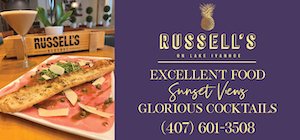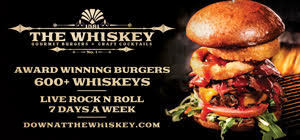I was telling a friend about a new restaurant in Winter Park called Limoncello and I commented that the only thing that disappointed me about the place was that it didn’t serve limoncello.
“A lot of places don’t serve lemon Jell-O,” my friend replied.
No, no, I explained, not lemon Jell-O, limoncello. It’s an Italian liqueur, usually served at the end of a meal as a digestive. It’s a wonderful blend of the bitter and the sweet with a powerful alcoholic kick.
It’s gaining some recognition in the U.S., and I’ve even seen it on some Italian dessert menus along with ports, scotches and after-dinner drinks. The reason it can’t be served at its namesake restaurant in Winter Park is because Limoncello has a license to serve only beer and wine.
I first encountered limoncello (pronounced lih-mohn-CHEHL-loh) at a charming little restaurant in a neighborhood not far from the Coliseum in Rome. My friend and I ate on the sidewalk where a few tables had been arranged to take advantage of a warm fall evening. It was a beautiful setting with the soft lights of the illuminated Coliseum just visible through the trees; the only “music” was the chatter of our fellow diners (we were the only ones not speaking Italian). And the meal was delicious, just the sort of authentic experience one hopes to find in a foreign city.
Then, at the end of the meal, our server came out to our table, placed two small glasses in front of us and started to pour from a frosted bottle.
“No, no, no,” we told him, trying to think of an Italian phrase that would convey to him that we did not order anything else. After a couple of bad experiences with unscrupulous taxi drivers, we had become wary of getting taken for any other rides, as it were.
But the waiter just motioned to us that it was OK and continued. He poured. We sipped. And we decided whatever he was going to charge us for this elixir would be worth it.
In fact he charged us nothing. It was his way of thanking us for dining there (something we continue to do whenever in Rome). He told us it was called limoncello but he was unable to tell us anything else about it.
It wasn’t until the following year while staying in Sorrento on the Amalfi Coast that I saw limoncello again, and this time in a very big way.
Sorrento is a big lemon-growing area and we found ourselves visiting during a festival devoted to all things lemon, including limoncello. I learned that it was available in bottles and sold in any store that sold alcohol, but that most people in that region made their own.
Luigi Spasiano, chef at Winter Park’s Limoncello and a native of Sorrento, says that the liqueur has been around only about 15 years (others will tell you it has been around for centuries). He says someone with a lot of lemons from Sorrento paired up with someone on the island of Capri who had plenty of liquor. They devised a way to promote Sorrento’s most prevalent produce and limoncello was born.
After that visit to Sorrento, I called the guys at Caffe Positano in Apopka. Positano is just down the coast from Sorrento, so I thought just maybe they would have a recipe. I struck liquid gold. Roberto Barba, one of Caffe Positano’s owners, gave me his recipe. I made it and it turned out wonderfully. Now I can enjoy limoncello whenever I want, and I want quite often.
I’ve also discovered that there are as many recipes as there are limoncello lovers. Recipes, depending on who is telling the story, have been handed down over generations (or at least over 15 years) with tweaking and tinkering along the way. Barba’s recipe uses grain alcohol, though some recommend using vodka. If you use vodka, be sure to get 100 proof. This is strong stuff, and it’s probably not a good recipe to get the kids involved in.
And if you’re one of those cooks who likes to take a nip of whatever wine you’re cooking with (why else would you cook with wine?), you may want to refrain from hitting the grain alcohol.
The other variations involve how many lemons to use, what kind of lemons (some people swear that only lemons from Sorrento or Capri, or only organic fruit should be used) and how long to macerate the peels in the alcohol. The minimum is two weeks, but some recipes call for as much as 80 days. My latest batch soaked for three weeks and it was plenty lemony for my taste.
Limoncello makes a great gift during the holidays. I’m always hunting for small bottles I can fill and give to friends. If you’d like to do the same, you’d better get started.
Limoncello
1 bottle (750 ml) grain alcohol (Everclear or any 151 proof brand)
Peels of 6 or 7 lemons
2 ½ pints water
2 1/3 cups sugar
You’ll need a wide-mouth jar for the alcohol and fruit. The opening needs to be wide enough so you can get the peels out after the maceration period. Pour the alcohol into the jar and add the peels. When peeling the lemons, avoid getting too much of the white pith. A good way to peel the fruit is to cut off the ends of the lemon, place it on the now-flat bottom, and slice from top to bottom following the contour. Save the actual “meat” of the lemon for lemonade, or use it in your ice tea.
Now cover and let the alcohol and fruit sit on the kitchen counter, covered, for at least two weeks. (Note: it is OK to leave the kitchen during this period.)
Remove the peels from the alcohol and set aside. Line a sieve with cheesecloth and strain the alcohol into another container.
In a saucepan, combine the water and the sugar and add the well-soaked peels. Heat and stir the sugar until it is dissolves and begins to boil. Continue a slow boil for two more minutes. Remove and discard the peels and allow the syrup to cool to room temperature. If you try to proceed before the sugar water cools you’ll turn your alcohol cloudy.
Combine the alcohol and the sugar water – the color will change to a light, opaque yellow. Filter again through clean cheesecloth and bottle.
Store in the freezer; it must be served very cold. Serve in small glasses. Limoncello is meant to be sipped, although some people say it is good over ice with some club soda. Others like to serve it over ice cream or cake.
Heck, I bet it would taste good on lemon Jell-O.










